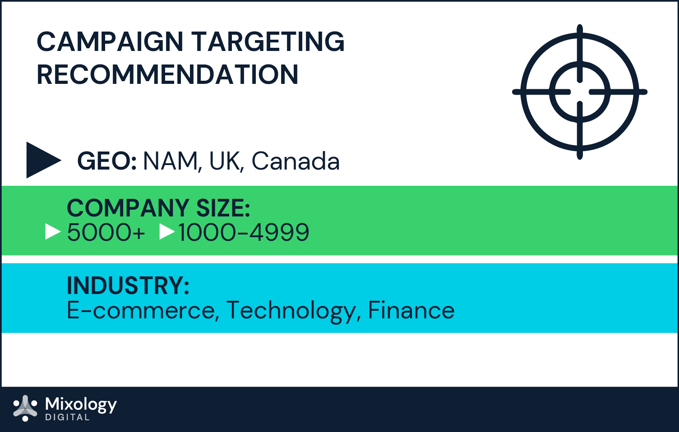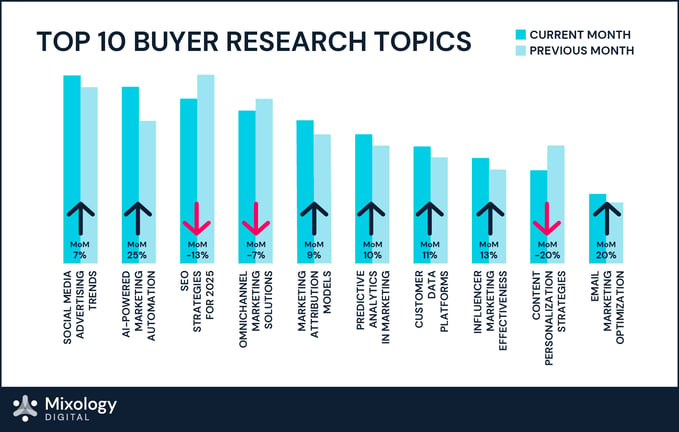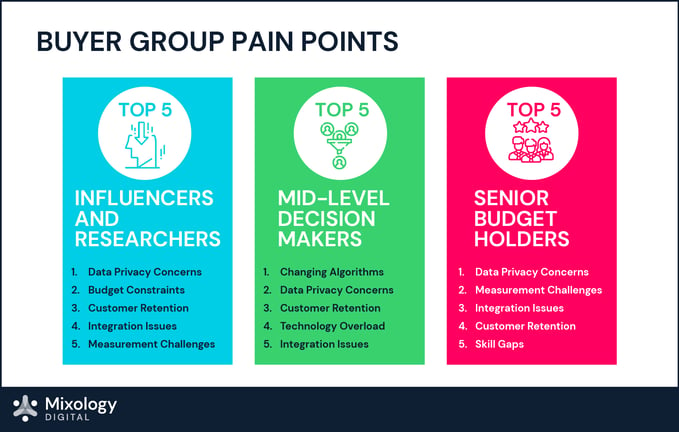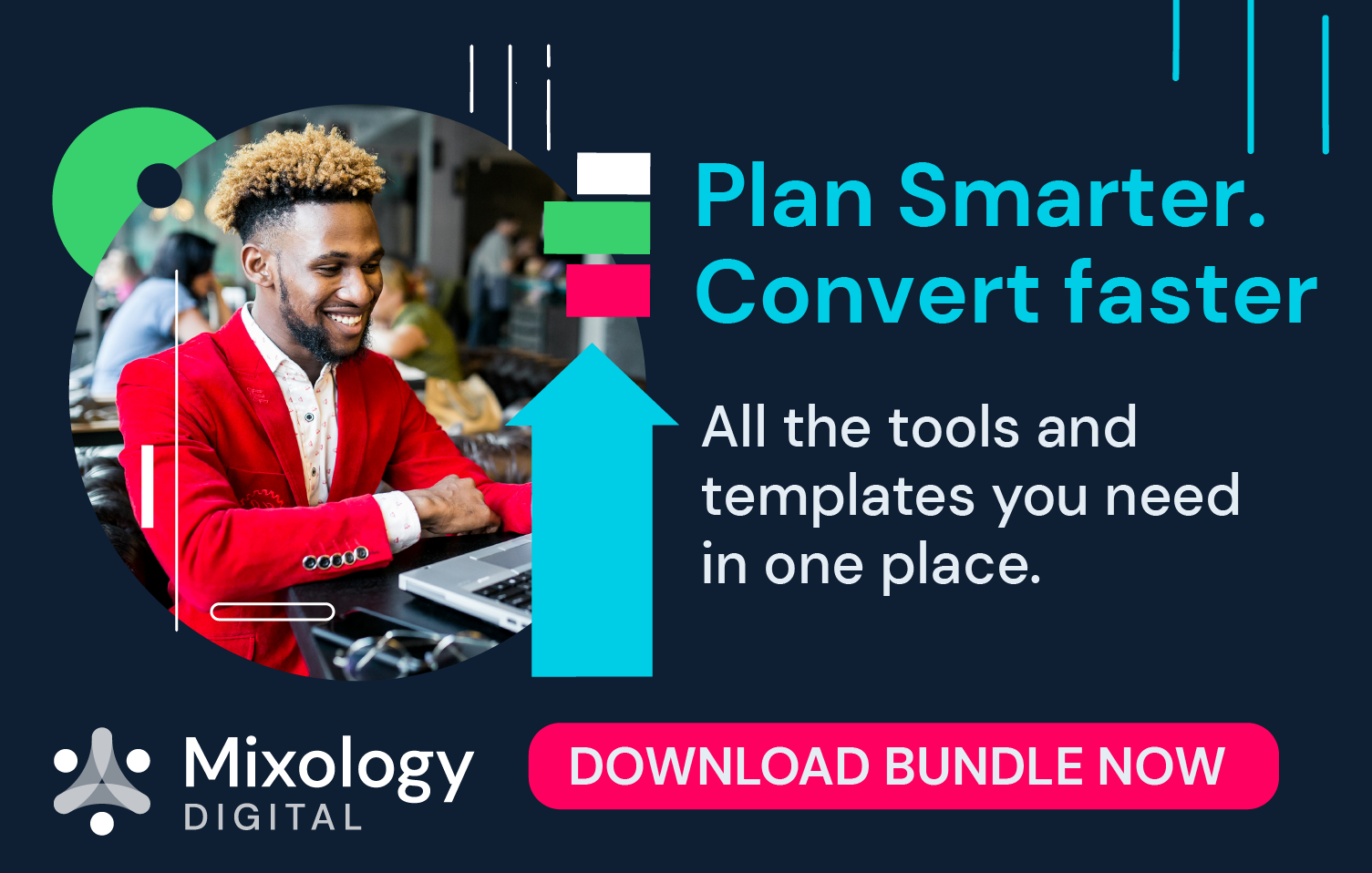Read time: 7 minutes
What’s been happening in the MarTech sector over the last 3 months?
Our Buyer Intelligence platform has been continuously tracking first-party buyer signals across our database, bringing you timely insights in the form of our latest marketing technlogy intent report.
Our mission? To help tech vendors keep their demand generation strategies tightly aligned to real market demand.
Published quarterly as part of our category-specific intent reports, our latest blog takes a deeper dive into the shifts most likely to impact your cloud and infrastructure campaigns — and how you can action these insights to drive success.
Ready to level up your strategy? Let's go...
Market snapshot
Here's what our latest MarTech intent report reveals about the current market:
- Interest is strongest in the ecommerce, technology, and finance industries.
- Traction is highest among enterprises with 1,000–5,000+ employees.
- Marketing, sales and product management functions show the greatest engagement with MarTech topics.

From insight to impact, here's how to apply our insight into your campaigns:
Targeting and segmentation action points:
1. Segment enterprise organisations in surging industries and geos into priority tiers.
2. Within these tiers, filter intent signals among trending job functions to inform topic clusters.
Why?
Segmenting your market into priority tiers helps to focus go-to-market teams on the accounts most likely to convert. Further segmentation techniques such as topic clusters opens up opportunities to tightly align content to specific audience segments. The result? Relevancy at scale.
Research patterns at account level
5 hot topics dominating research in the MarTech space (over the last 3 months), are:
- Social media advertising trends – Platform algorithm shifts and creative fatigue are pushing teams to test formats, placements, and audience mixes more often.
- AI-powered marketing automation - Buyers want faster execution and smarter triggers; expect interest in AI‑assisted workflows and content generation safeguards.
- SEO strategies for 2025 - With search changing (AI overviews, zero-click results), leaders seek durable technical and content strategies that protect organic reach.
- Omnichannel marketing solutions - Demand for unified journeys and consistent messaging across web, email, social, and retail is accelerating.
- Marketing attribution models - Teams are comparing multi-touch approaches and MMM to prove ROAS and guide budget allocation.
The topic showing the greatest decline in popularity is:
- Content personalisation strategies with a 20% MoM decrease

What do these insights mean for your content strategy?
To keep your strategy aligned to market demand, we recommend:
- Anchor top-funnel content in social ads trends and AI automation explainers; pair with quick wins and guardrails.
- Build MOFU assets around omnichannel orchestration and integration demos that show the stack working end-to-end.
- Ship BOFU tools that help buyers choose attribution models and quantify impact (MMM vs. MTA) with templates and calculators.
Pro tip: Use AI/NLP tools (topic modelling, entity extraction, semantic clustering) to audit your content library against competitor coverage. Flag underserved subtopics and build differentiated assets where demand is growing fastest.
Buyer group analysis
For marketing technology buyers, complexity, cost, and scalability dominate decision-making. Our report shows the order in which buyers prioritise these factors depends on their role and seniority.

What does this mean for your persona development?
Tailoring content to buyer role nuances is critical for engagement and conversion. Here's how you can translate these insights into accurate personas.
Persona A: Influencers and researchers (typically Marketing Executives or digital specialists)
- Concerns: changing algorithms, technology overload, data privacy; navigating constant updates across social and search platforms while trying to keep tech stacks efficient and compliant.
- Content preferences: they want practical, digestible resources such as educational blogs, benchmark reports, and explainer videos that break down complex concepts.
Persona B: Mid‑level decision makers (such as Marketing Managers and Sales Managers)
- Concerns: integration issues, customer retention, and measurement challenges; they’re under pressure to prove campaign ROI while managing multiple systems that don’t always communicate seamlessly.
- Content preferences: they want to see case studies that show measurable outcomes, ROI snapshots tied to campaign success, and solution comparison guides that reduce perceived risk.
Persona C: Senior budget holders (such as CMOs, VPs of Marketing, Heads of Digital)
- Concerns: pressure around budget constraints, ROI attribution, and long-term scalability; they’re focused on balancing innovation with fiscal responsibility.
- Content preferences: they need clear, data‑backed resources that help them make confident investment decisions, such as board‑ready decks, pricing calculators, and strategic frameworks.
Action point: Create a persona matrix aligned to job functions. Map their pain points against the funnel stages they are most likely to participate in. For example, Marketing Executives may engage early with trend reports, while CMOs and will respond to BOFU tools such as ROI calculators.
Recommended reading: How to map content to the new buyer journey
3 MarTech demand gen plays:
Our AI Buyer Intelligence platform is able to interrogate research patterns by buyer stage. Here's how to action these insights into a full-funnel demand gen strategy aligned to real buyer behaviour:
Primary keyword focus:
- Emerging marketing technologies
- AI in marketing automation
- Data privacy regulations
- Customer experience trends
- Social media advertising innovations
How to use them: Build headlines and H1s around one primary keyword plus a contextual cue (e.g. industry, region, or business size).
Example: “Emerging MarTech innovations transforming customer experiences in 2025.”
Recommended plays:
- Publish a gated Future of Marketing Tech & AI trend report.
- Run an awareness campaign using blogs, videos, and infographics around data privacy, omnichannel marketing and customer experience trends.
- Launch a Marketing Tech Readiness Self-Assessment tool that covers automation, data integration and omnichannel maturity, to support nurture flows.
Assets to ship:
- 1 x flagship report
- 2× infographics
- 3–5× short-form videos
- 1× checklist or quiz
Copy cues: Lead with transformation and innovation themes; avoid jargon and focus on what’s next.
Signals to watch: Rising search activity around automation, privacy, and omnichannel maturity.
Primary keyword focus:
- Comparative analysis of marketing tools
- Case studies on successful campaigns
- Integration of marketing platforms
- Cost-benefit analysis of marketing solutions
- User reviews and testimonials
How to use them: Focus content on evaluation support and social proof. Combine comparative insights with integration walkthroughs to help buyers connect platform capabilities to measurable success.
Example: “Choosing the right MarTech stack for measurable ROI.”
Recommended plays:
- Create vendor comparison guides (CRM, MAP, CDP) and host webinars with integration demos.
- Share case study ebooks and testimonial videos showing real-world success stories.
- Provide trial access or workshop sessions supported by training resources and access to peer community.
Assets to ship:
- 1 x ebook
- 2 x webinars
- 3 x demo videos
Copy cues: Anchor your messaging around clear, tangible outcomes such as improved efficiency, measurable ROI, and greater user satisfaction. Each piece of content should show how the solution simplifies processes and delivers performance gains that buyers can quantify.
Signals to watch: Keep a close eye on rising engagement with comparison and evaluation content, a clear sign that buyers are weighing their options and moving toward shortlisting vendors.
Primary keyword focus:
- Finalising vendor selection
- Negotiating contracts and pricing
- Implementation strategies
- Onboarding and training processes
- Measuring success post-implementation
How to use them: Focus your messaging on clarity, assurance, and proof of performance. Use narratives that emphasise strong onboarding, seamless implementation, and measurable post‑launch success to demonstrate reliability and long‑term value.
Example: “Finalising your MarTech investment: From vendor selection to successful implementation and measurable ROI.
Recommended plays:
- Offer a negotiation toolkit including pricing benchmarks, TCO calculators and SLA templates.
- Deliver implementation roadmaps and training packs to support onboarding.
- Build board-ready decks to showcase ROI measurement and scalability to support final sign-off.
Assets to ship:
- 1 x toolkit
- 1 x roadmap deck
- 2 x ROI guide
Copy cues: Reinforce value, instil confidence, and highlight long-term performance. Make it clear that your solution delivers measurable results and sustained ROI.
Signals to watch: Look for decision-stage accounts actively engaging with content about pricing, vendor comparisons, and ROI, this behaviour signals readiness to make a final purchase decision.
Tip: Keep the exact keyword phrases in page titles, H2s, alt text, and internal links so performance teams can tie content to intent spikes and prioritise syndication/remarketing accordingly.
Ready to activate these insights?
Why not try our demand gen planning framework? It’s a collection of templates and planning aids, including:
- Buyer group intent mapping
- Multichannel campaign blueprint
- Funnel‑aligned strategy shortcuts
Everything you need to turn category intent insights into campaigns that convert.





